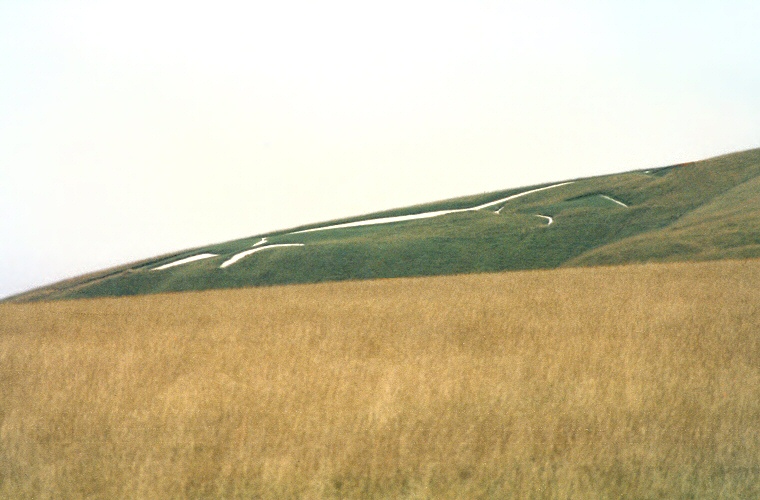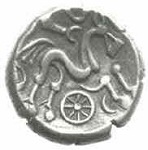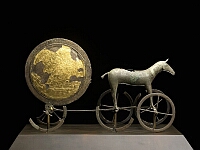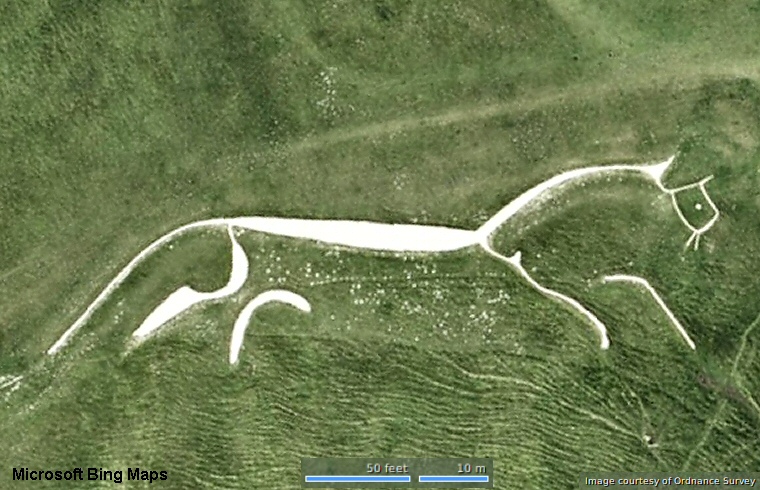
The White Horse seen from Dragonhill Road, the eye can be seen as the white dot towards the upper right.
 The figure was first recorded in the late 11th century but is thought to be over a thousand years older, probably dating from the Iron
Age, perhaps from about the time of the Roman conquest, as it is similar to depictions
of horses from this period as seen on contemporary coins and as such may represent
the tribal emblem of the Dobunni or Atrebates tribes - the image to the left shows just such a coin of the Atrebates. It is also believed the Iron Age Britons may have
worshiped a equine deity which may have been the British counterpart of the Gaulish horse goddess
Epona so the figure may be a symbolic and devotional representation of this goddess.
The figure was first recorded in the late 11th century but is thought to be over a thousand years older, probably dating from the Iron
Age, perhaps from about the time of the Roman conquest, as it is similar to depictions
of horses from this period as seen on contemporary coins and as such may represent
the tribal emblem of the Dobunni or Atrebates tribes - the image to the left shows just such a coin of the Atrebates. It is also believed the Iron Age Britons may have
worshiped a equine deity which may have been the British counterpart of the Gaulish horse goddess
Epona so the figure may be a symbolic and devotional representation of this goddess. Some stories however place the horse much later in history, perhaps from the 5th century AD and claim it was cut on the orders of the Anglo-Saxon leader Hengist of Kent (Hengist means 'horse'), others say it may be even later, from the 9th century and commemorates King Alfred's victory over the Danes.
Like the Cerne Giant the White Horse used to be scoured every 7 years (I'm not sure if this tradition still continues) which involved removing the old and discoloured surface layers of chalk and replacing them with a fresh layer to maintain the figure's appearance. It is said that the nearby earthworks enclosure of the late Bronze Age / early Iron Age hillfort of Uffington Castle less than 200 metres away to the southwest was the site of festivities on these occasions.
According to legend it was the magical blacksmith Wayland himself that hammered the shoes for the White Horse while another claims that a wish may be made while standing on the eye of the Horse. About 200 metres to the north of the White Horse the natural knoll of Dragon Hill is said to be where St. George slew the dragon of legend, the blood spilt from the beast being so toxic that no vegetation will now grow on the top of the knoll.
Update:
In 1995 a team from the Oxford Archaeological Unit excavated parts of the figure and used a technique known as Optical Stimulated Luminescence (which calculates how much time has passed since a substance such as chalk was last exposed to sunlight) to date the original White Horse figure to between 1400BC-600BC. This is significantly earlier than had previously been believed and pushes the White Horse back from the late Iron Age into the middle Bronze Age to early Iron Age period making it probably contemporary with the earlier stages of Uffington Castle hillfort.
Update:
Author and archaeologist Josh Pollard sees the Uffington figure as the embodiment of a 'sun-horse' that he says was 'created to perform in a landscape'. It is believed that the cosmological beliefs across north-western
 Europe from at least the second millennium BC viewed the sun as a divine entity that was pulled east to west across the sky during the day by various creatures, including a horse. The image left is believed to show such a horse made of bronze with the sun represented by a gold disc - the model was found in a peat bog in Trundholm, Denmark and is dated to around 1400 BC. At night the sun continued its journey transported eastwards on boats through a watery underworld to be reborn the following morning when the eternal cycle began again. Pollard suggests that around mid-winter the sun when seen from Dragon Hill appears to set in the vicinity of Wayland's Smithy and speculates that the chambers of the tomb, which would have been around 2000 years old when the horse was cut, may have been regarded as portals to the underworld where the sun began its nocturnal travels.
Europe from at least the second millennium BC viewed the sun as a divine entity that was pulled east to west across the sky during the day by various creatures, including a horse. The image left is believed to show such a horse made of bronze with the sun represented by a gold disc - the model was found in a peat bog in Trundholm, Denmark and is dated to around 1400 BC. At night the sun continued its journey transported eastwards on boats through a watery underworld to be reborn the following morning when the eternal cycle began again. Pollard suggests that around mid-winter the sun when seen from Dragon Hill appears to set in the vicinity of Wayland's Smithy and speculates that the chambers of the tomb, which would have been around 2000 years old when the horse was cut, may have been regarded as portals to the underworld where the sun began its nocturnal travels. 
Bing satellite view of the Uffington White Horse.
Before the gods that made the gods
Had seen their sunrise pass,
The White Horse of the White Horse Vale
Was cut out of the grass.
Before the gods that made the gods
Had drunk at dawn their fill,
The White Horse of the White Horse Vale
Was hoary on the hill.
Age beyond age on British land,
Aeons on aeons gone,
Was peace and war in western hills,
And the White Horse looked on.
For the White Horse knew England
When there was none to know;
He saw the first oar break or bend,
He saw heaven fall and the world end,
O God, how long ago.
From 'The Ballard of The White Horse' by G. K. Chesterton.
Site Visits / Photographs:
Summer 1984, August 1997.
References:
Ashe, G. 1990. Mythology of the British Isles. London: Methuen.
Briard, J. 1979. The Bronze Age in Barbarian Europe. London: Book Club Associates.
Brown, I. 2009. Beacons in the Landscape - The Hillforts of England and Wales. Oxford: Oxbow Books.
Chesterton, G. K. 1911. The Ballard of The White Horse. London: Metheun.
Darvill, T. 2010. Prehistoric Britain. 2nd Edition. Abingdon: Routledge.
Dyer, J. (Editor). 1993. Discovering Prehistoric England. Princes Risborough: Shire Publications Ltd.
Godwin, F. and Anderson, J.R.L. 1987. The Oldest Road: The Ridgeway. London: Whittet Books.
Hawkes, J. 1986. The Shell Guide to British Archaeology. London: Michael Joseph Ltd.
Nationalmuseet Danmark. 2020. Solvognen fra Trundholm (Sun Horse Image).
Pettigrew, T. 1860. On the History and Antiquities of Berkshire. Journal Brit. Arch. Assoc., 16, 25-49.
Pollard, J. 2017. The Uffington White Horse geoglyph as sunhorse. Cambridge University Press.
Whitlock, R. 1979. In Search of Lost Gods. A Guide of British Folklore. Oxford: Phaidon Press.
Historic England Research Records Hob Uid: 229205. NMR Number: SU 38 NW 1.